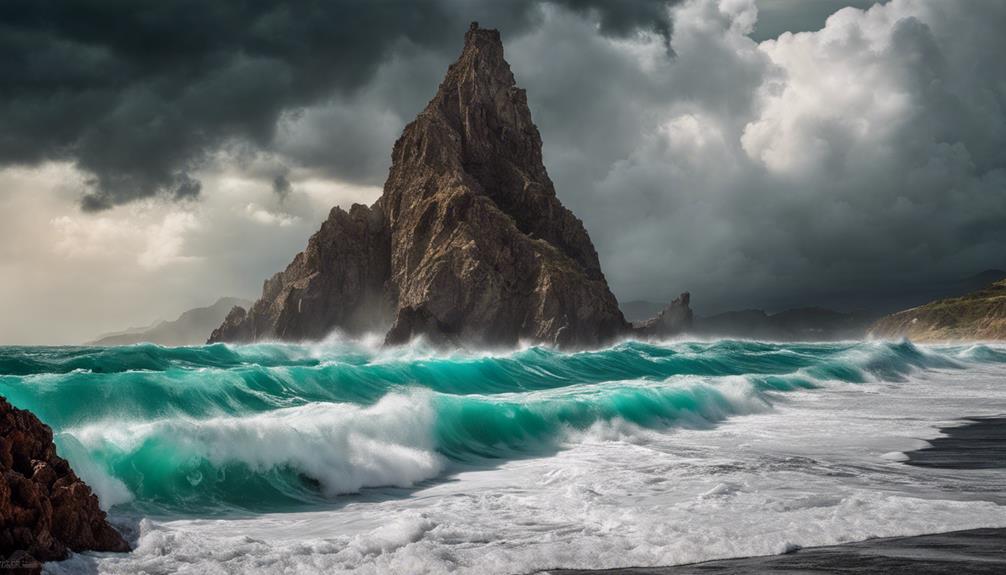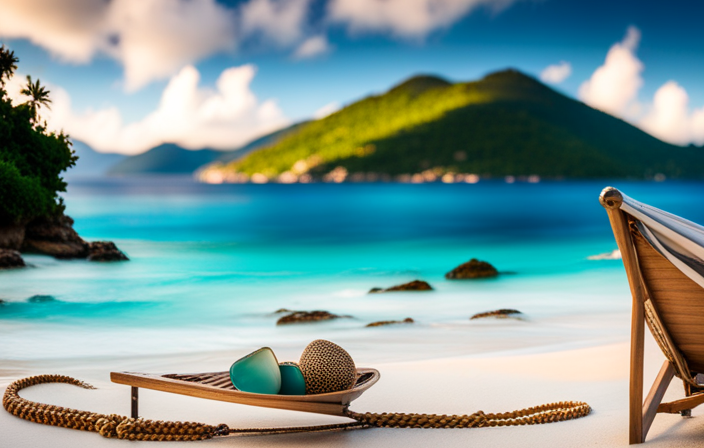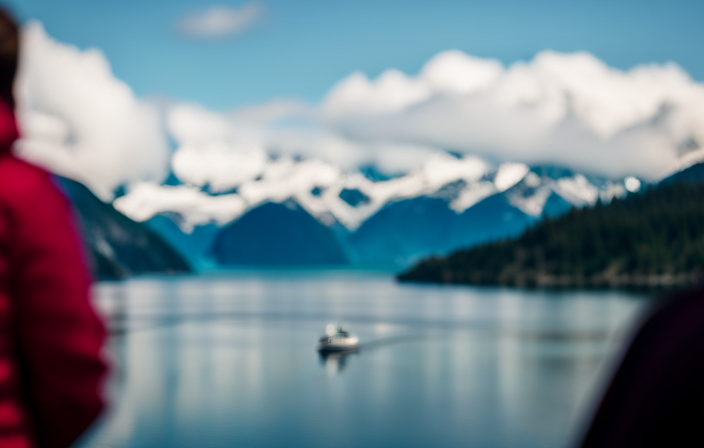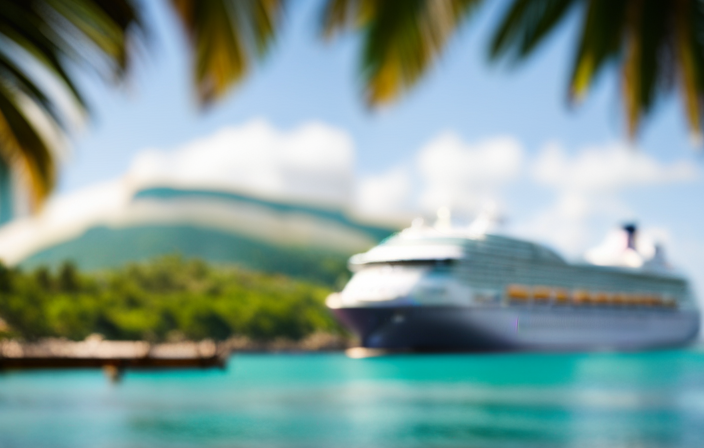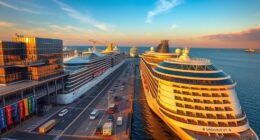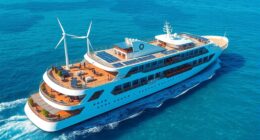Walking onto a cruise ship feels like stumbling upon a city adrift on the ocean. As I stroll around the expansive vessel, I am captivated by its construction. I learned that it is constructed from a mix of materials including steel, aluminum, wood, and marble, all coming together to create this massive structure.
The structure of the ship is built with steel and aluminum, providing the sturdy framework that allows it to withstand the mighty waves of the ocean. Inside, the ship’s interior is adorned with luxurious wood finishes and elegant marble accents, creating a sophisticated and welcoming atmosphere.
Plumbing and electrical systems run seamlessly behind the scenes, ensuring comfort and convenience for all passengers. From cabins and suites to restaurants and entertainment venues, the ship’s accommodations cater to every traveler’s needs.
Beyond the aesthetics, cruise ships also prioritize sustainability, implementing environmentally friendly practices. And of course, let’s not forget the navigation and propulsion systems that keep the ship sailing smoothly through the open waters.
With careful maintenance and upkeep, these magnificent vessels continue to provide unforgettable experiences for travelers worldwide.
Key Takeaways
- Cruise ships are primarily made of steel and aluminum, which provide strength, durability, and resistance to corrosion.
- The interior of cruise ships is often adorned with wood and marble finishes, creating a luxurious and elegant atmosphere.
- Plumbing and electrical systems are crucial for the smooth operation of amenities and the safety of passengers and crew.
- Cruise ships prioritize passenger safety with fireproofing materials, advanced fire detection systems, and strategically placed life-saving equipment.
The Structural Frame: Steel and Aluminum
Cruise ships are typically constructed using a combination of steel and aluminum in their structural frame. Steel fabrication provides the necessary strength and stability to withstand the harsh conditions of the open sea. It is chosen for its exceptional durability and resistance to corrosion, which is crucial for a vessel constantly exposed to saltwater.
Aluminum, on the other hand, is used to reduce weight and increase fuel efficiency. It is also highly resistant to corrosion and offers an excellent strength-to-weight ratio.
The combination of these materials ensures that cruise ships are not only robust but also efficient in terms of performance.
Moving on to the next section about interior finishes, wood and marble are commonly used to create a luxurious and elegant ambiance onboard.
Interior Finishes: Wood and Marble
Exquisite wood and marble finishes adorn the interiors of these luxurious floating palaces. The craftsmanship and attention to detail in these finishes are truly remarkable. Here are three reasons why these wood and marble finishes contribute to the opulence of cruise ship interiors:
-
Wood finishes: The warm tones and intricate patterns of wood bring a sense of elegance and sophistication to the cabins and common areas. From mahogany panels to teak flooring, the use of high-quality wood creates a luxurious ambiance.
-
Marble finishes: The smooth and polished surfaces of marble add a touch of grandeur to the cruise ship interiors. Marble is used in various areas, such as bathrooms, foyers, and bars, creating a sense of luxury and refinement.
-
Combination of wood and marble: The blend of wood and marble finishes creates a harmonious and visually stunning environment. It enhances the overall aesthetic appeal and elevates the experience of passengers.
As we delve into the next section about plumbing and electrical systems, the attention to detail seen in the wood and marble finishes extends to every aspect of cruise ship design.
Plumbing and Electrical Systems
Immerse yourself in the intricacies of the plumbing and electrical systems, where meticulous engineering seamlessly integrates modern technology into the luxurious framework of these floating marvels. The plumbing system on a cruise ship is a complex network of pipes, pumps, and valves that ensure the smooth operation of toilets, showers, sinks, and other water-based amenities. Regular plumbing maintenance is crucial to prevent leaks and maintain the overall functionality of the system. On the other hand, the electrical system is responsible for powering the ship’s lighting, appliances, and entertainment systems. Electrical wiring safety is of utmost importance to prevent electrical hazards and ensure the safety of passengers and crew members. The ship’s electrical system is designed to operate on a closed loop, meaning that power is generated and distributed throughout the ship without relying on external sources. As we move on to the next section about accommodations: cabins and suites, you will see how the plumbing and electrical systems seamlessly integrate into the overall design and functionality of the ship.
Accommodations: Cabins and Suites
Step into your cozy cabin or luxurious suite and experience the comfort and elegance of your floating home away from home. The cabin decor is carefully designed to create a serene and inviting atmosphere, with soothing colors, plush bedding, and tasteful furnishings.
Suites offer an additional level of luxury, with spacious living areas, separate bedrooms, and private balconies that provide breathtaking views of the ocean. In addition to the standard amenities such as a private bathroom and storage space, cabins and suites also offer a range of thoughtful touches, including flat-screen TVs, mini fridges, and in-room safes.
Whether you choose a cozy cabin or a lavish suite, you can expect a tranquil retreat where every detail has been carefully considered.
As we move on to the next section about onboard amenities, you’ll discover a world of culinary delights, vibrant bars, and captivating entertainment options.
Onboard Amenities: Restaurants, Bars, and Entertainment
Indulge in the delectable cuisine, savor the finest cocktails, and be entertained by captivating performances throughout your voyage. Cruise ships offer a plethora of onboard entertainment options to ensure a memorable experience.
From Broadway-style shows to live music performances, there is something for everyone. The ship’s restaurants provide specialty dining experiences, serving a wide array of international cuisines prepared by world-class chefs. Whether you are in the mood for a gourmet steakhouse or a tantalizing sushi bar, the options are endless.
Additionally, the bars onboard offer a variety of handcrafted cocktails and a carefully curated wine list to satisfy even the most discerning palate. As you indulge in these culinary delights and enjoy the entertainment, you can rest assured knowing that the ship is equipped with state-of-the-art safety features, including fireproofing and life-saving equipment, to ensure your well-being throughout your journey.
Transitioning to the next section, let’s explore the ship’s safety features.
Safety Features: Fireproofing and Life-saving Equipment
As you explore the ship, you can’t help but wonder about the hidden safety measures in place, ensuring your well-being in case of any emergencies. Cruise ships are meticulously designed to prioritize passenger safety. They have fire suppression systems and life-saving equipment strategically placed throughout the vessel.
Fireproofing materials, such as fire-resistant paints and coatings, are used extensively in critical areas to prevent the spread of fire. Advanced fire detection systems are also installed to detect any signs of smoke or heat.
In the event of an emergency, the crew is trained to swiftly deploy lifeboats and other life-saving equipment to ensure the safe evacuation of all passengers. These safety features undergo regular inspections and maintenance to ensure their effectiveness.
Transitioning into the subsequent section about ‘environmental considerations: sustainable practices’, it’s important to note that cruise ships also prioritize sustainable practices to minimize their environmental impact.
Environmental Considerations: Sustainable Practices
In considering the environmental impact of cruise ships, it’s important to examine the use of eco-friendly materials and technologies. By utilizing sustainable materials and implementing environmentally-friendly technologies, cruise ships can reduce their carbon footprint and minimize harm to the ecosystem.
Additionally, waste management and water conservation efforts play a crucial role in ensuring the sustainability of cruise ship operations. Proper waste management practices and efficient water conservation measures contribute to the preservation of natural resources and the overall well-being of the environment.
Use of eco-friendly materials and technologies
Cruise ships today are incorporating eco-friendly materials and technologies to enhance the guest experience. This includes:
-
Energy efficient lighting: LED lights are being used throughout the ship, reducing energy consumption and improving overall efficiency.
-
Use of renewable energy sources: Cruise ships are now equipped with solar panels and wind turbines to generate electricity, reducing reliance on fossil fuels.
-
Advanced wastewater treatment systems: These systems utilize innovative technologies to treat and recycle wastewater, minimizing environmental impact.
-
Smart HVAC systems: High-efficiency heating, ventilation, and air conditioning systems are being installed to reduce energy consumption and improve air quality onboard.
By implementing these sustainable practices, cruise ships aim to minimize their carbon footprint and promote a greener future. Moving forward, waste management and water conservation efforts will be discussed, further highlighting the industry’s commitment to environmental stewardship.
Waste management and water conservation efforts
Cruise ships have implemented innovative waste management and water conservation efforts to transform their environmental impact and pave the way for a more sustainable future. On board, advanced sorting systems, composting, and recycling programs are used to reduce waste sent to landfills and minimize the ships’ environmental footprint. Water conservation is also prioritized through water recycling methods. Advanced filtration systems and desalination plants treat wastewater to meet strict environmental standards before discharge, reducing freshwater demand and preventing marine pollution. These waste management and water conservation efforts demonstrate the cruise industry’s commitment to a greener industry. As we transition to discussing navigation and propulsion systems, it is important to consider how these advancements complement the overall sustainability of cruise ships.
Navigation and Propulsion Systems
Cruise ships are constructed with a variety of materials. They utilize advanced navigation and propulsion systems to ensure smooth and efficient travel on the open seas.
Navigation systems play a crucial role in guiding the ship. They use a combination of satellite communication, radar, and GPS technologies. These technologies determine the ship’s position, course, and speed. With accurate navigation, collision avoidance, and efficient routing, these systems are essential for safe travel.
Propulsion technologies provide the necessary power to move the ship through the water. Most cruise ships use diesel-electric propulsion systems. These systems involve diesel engines driving generators that produce electricity. The electricity then powers electric motors connected to propellers. This setup allows for better fuel efficiency and reduced emissions.
The ship’s navigation and propulsion systems work hand in hand with the physical attributes of the vessel. They ensure safe and efficient operation. Transitioning into the subsequent section on exterior design: paint and sealants, these systems play a vital role in the overall functionality of the cruise ship.
Exterior Design: Paint and Sealants
When it comes to the exterior design of a cruise ship, paint durability and sealant effectiveness are crucial factors to consider. The paint used on cruise ships must be able to withstand the constant exposure to saltwater, UV radiation, and extreme weather conditions. It should also provide protection against corrosion and fading.
Sealants are applied to fill and seal gaps, preventing water intrusion and potential damage. They must be effective in creating a watertight seal that can withstand the constant movement and vibrations of the ship.
Proper maintenance and upkeep of the paint and sealants are essential to ensure the longevity and appearance of the cruise ship’s exterior.
Maintenance and Upkeep
After discussing the exterior design of cruise ships, let’s move on to the crucial aspect of maintenance and upkeep. To ensure the longevity and safe operation of these vessels, diligent maintenance techniques and regular equipment upkeep are imperative.
Maintenance procedures include routine inspections of the ship’s structure, machinery, and systems. This involves checking for corrosion, leaks, or any signs of wear and tear. Specialized equipment, such as ultrasound thickness gauges and non-destructive testing methods, are utilized to assess the integrity of the ship’s hull and other critical components.
Moreover, the upkeep of equipment is of utmost importance. This includes regular servicing, lubrication, and calibration of machinery to prevent breakdowns and ensure optimal performance. Advanced technology is employed to monitor and assess the condition of equipment, enabling timely repairs or replacements.
By meticulously adhering to maintenance protocols and equipment upkeep, cruise ship operators can guarantee the safety and reliability of their vessels, providing passengers with a smooth and enjoyable voyage.
Frequently Asked Questions
How many cabins and suites are typically found on a cruise ship?
Typically, a cruise ship has a range of cabins and suites, with the cabin capacity varying depending on the size of the ship. Suites often offer more luxurious amenities and larger living spaces compared to cabins.
What are the most common types of onboard amenities offered on cruise ships?
Onboard amenities on cruise ships include a wide range of entertainment options, such as live shows, casinos, and movie theaters. Dining options are also abundant, with multiple restaurants, buffets, and specialty dining venues available.
What safety measures are in place to protect passengers from fires?
To ensure passenger safety, cruise ships implement various fire prevention measures such as state-of-the-art fire detection systems, fire-resistant materials, and rigorous safety protocols. Additionally, emergency evacuation procedures are regularly practiced and crew members are trained in firefighting techniques.
What are some sustainable practices employed by cruise ships to minimize their environmental impact?
Cruise ships employ sustainable practices to minimize environmental impact. This includes using sustainable fuel options like biodiesel and LNG, as well as implementing effective waste management systems to reduce pollution and promote recycling.
How often do cruise ships undergo maintenance and what kind of upkeep is typically required?
Cruise ship maintenance schedules vary based on the ship’s size and usage. Typically, scheduled maintenance includes hull inspections, engine overhauls, and safety equipment checks. Regular upkeep is essential to ensure the ship’s optimal performance and passenger safety.
Conclusion
In conclusion, cruise ships are marvels of engineering and design. They are constructed using a combination of steel and aluminum for their structural frame, ensuring strength and durability.
The interiors boast luxurious finishes, with wood and marble adding a touch of elegance. Plumbing and electrical systems are carefully installed to provide comfort and convenience for passengers.
From cozy cabins to spacious suites, accommodations cater to every traveler’s needs. Onboard amenities like restaurants, bars, and entertainment venues offer a diverse range of experiences.
Environmental considerations are also taken into account, with sustainable practices implemented to reduce the ship’s carbon footprint. Navigation and propulsion systems ensure smooth sailing, while the exterior design is enhanced with carefully chosen paint and sealants.
Regular maintenance and upkeep are crucial to keep these floating wonders in top condition. Coincidentally, all these intricate details come together to create unforgettable experiences for cruise ship passengers.


